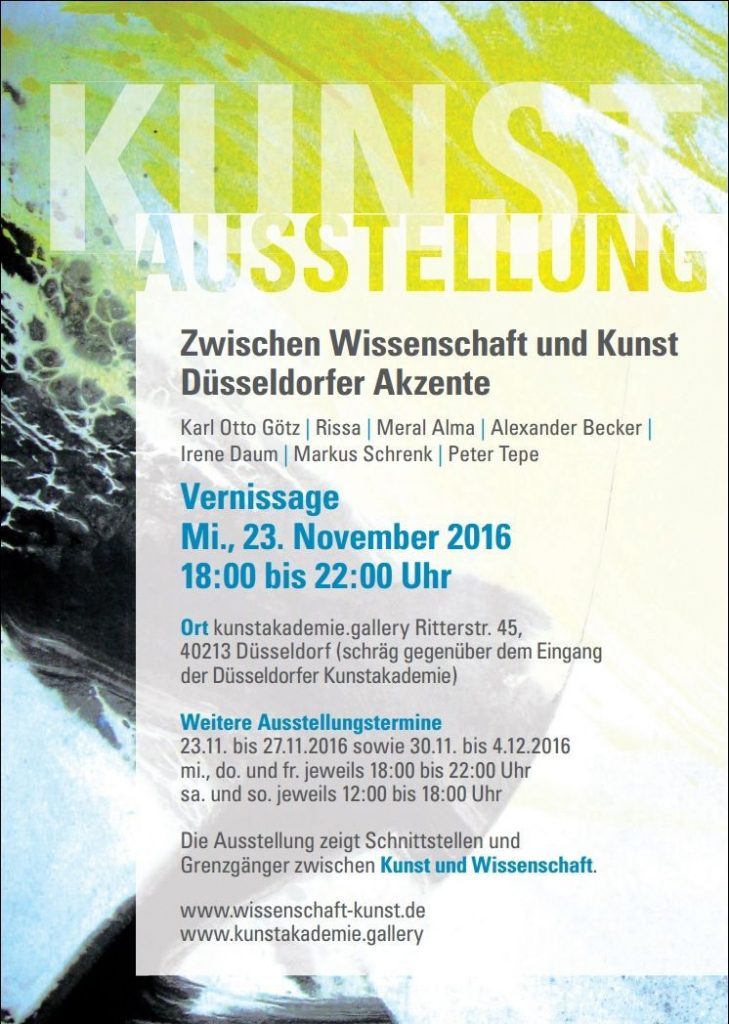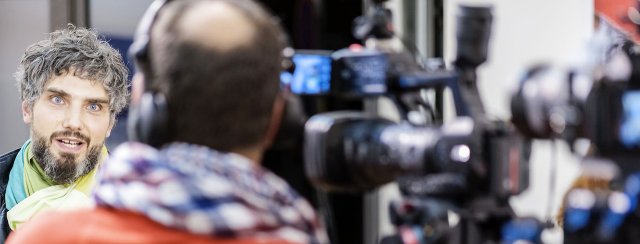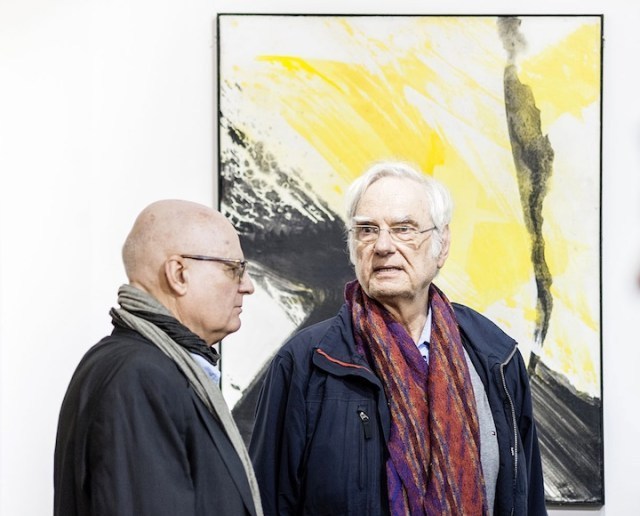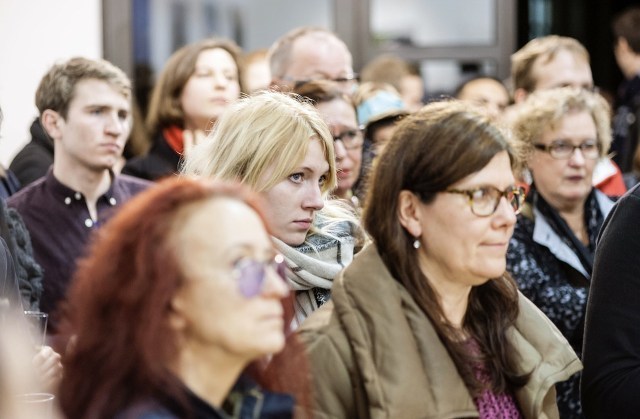The exhibition Zwischen Wissenschaft und Kunst: Düsseldorfer Akzente (Between Science and Art: Düsseldorf Accents) took place from 23.11. to 4.12.2016 at the Kunstakademie.gallery in Ritterstraße 45 opposite the Düsseldorf Art Academy.
This report contains the welcoming speech given by w/k publisher Peter Tepe on 23.11.2016, photos by Karsten Enderlein, as well as the video published on center.tv on the occasion of the vernissage and two other videos.


Welcoming speech of the w/k editor
The exhibition Between Science and Art: Düsseldorf Accents, to which I warmly welcome you, is closely linked with the new online journal w/k – Between Science and Art, that first went public at the beginning of November. You’ll find it on the internet under: www.wissenschaft-kunst.de and www.wissenschaft-kunst.com; the latter is the direct link to the english version of w/k.
For the launch issue, contributors with a connection to Düsseldorf were invited to take part in this exhibition: the idea was to place a focus on Düsseldorf. For all contributors there is a chart showing the central statements of an interview, an essay or an article – as an invitation to read the full text in our online journal. In addition to this, artistic works by five participants are also being presented.
In simple terms, w/k is concerned with the manifold connections between the realms of science and visual arts. The exhibiting artists can all be located within this broadly defined spectrum. For instance, Karl Otto Götz and Rissa were not only active over a long period as artists and served as professors of art at the Düsseldorf Art Academy, but for many years they also worked as empirical scientists, performing psychological studies to determine the purpose of exact aesthetics. For w/k, their willingness not only to do an interview but also to submit two works to our exhibition represented an outstanding gesture of support, for which I wish to express my warmest thanks.
The first variety of connection between science and art that we can define as “border crossing” between the two realms, could be said to include Meral Alma. Not only is she the two-time winner of the academy’s talent award and an artist who has already succeeded in positioning herself remarkably well in the art world – she is at the same time also working on her PhD thesis in philology.
A further border crosser between the two domains, but loaded more in the direction of science, is Professor Markus Schrenk. While teaching theoretical philosophy at Heinrich Heine University, at times he is also active as an artist. In our exhibition he shows an intricate thought-provoking installation which is discussed in w/k in an essay by Sonja Frenzel.
A second type of link between science and art is represented by Professor Alexander Becker. Having taught philosophy at Düsseldorf University for a number of years, in 2015 he was offered a chair at the University of Marburg. He explores on a theoretical level the relationship between art and science; in his contribution to w/k he endeavours to define this relationship from a new perspective.
A similar angle is also evident in the essay by Professor Irene Daum. The psychologist and neuroscientist summarises what present-day psychology has to say about visual arts, artists and the reception of art. Irene Daum also belongs to the community of “border crossers”, since she herself is, in addition, a photographer as well as having conceived art exhibitions for many years and written texts about artists.
How I myself should be classified in this is apparent from the title of the chart. For the exhibition I have chosen works that mainly bear reference to my activity as a scientist. This also gives me the opportunity to point out a third type of connection between science and art that in general is far more prevalent than can be seen in the work of these particular “border crossers” on display here. The past few decades have been a period of boom for artists who in one form or another make reference to scientific theories and findings. Take, for instance, the incorporation of climate research in order to highlight the ecological crisis with artistic means. Several of these artists whose work is science-related are presented in the first edition of w/k. So much for the exhibition.
Yet before I finish my welcome address I wish to express my thanks to all those, without whom this internationally oriented, bi-lingual online journal would not have happened in its current, remarkable form. Dr Hans Ulrich kindly financed several of the translations into English, Professor Bodo Kirf and Henri Berners supported us with important PR work that was needed to launch w/k, and Wolfgang Kessler also assisted us with his advice. Irene Daum and Alexander Becker already joined the editing team in the initial project phase in 2013/14 and contributed to the further development of the original concept. They established contacts with artists and scientists and also contributed articles to the maiden edition. Giovanni Tepe works as a systems administrator and is always at hand when we need him. The artist Bertram Rutz, who works at Museum Kunstpalast, lent us very spirited support in hanging the works. My warmest thanks go to all those I have just named.
But in particular, I would like to thank the core circle of the editorial team which, besides myself, consists of three people. This group has worked extremely hard over the past year, especially during the last few months. When faced with various new problems that emerged in the process they came up with creative solutions which after intense debate also consistently ended in agreement on all sides. It’s enough to bring tears to my eyes when I think back to this intense period of productive fermentation.
Let me begin with Meral Alma, whereby I wish to focus on just one aspect of her activity. Without her there could never have been a first w/k exhibition so few weeks after the launch. Some time ago she founded the internet portal kunstakademie.gallery and launched the regular ART After Work event in the space where we are now standing. Thanks to her we were able at short notice to use this gallery to present a w/k exhibition. In the final weeks before the show she went full out, pouring most of her almost indefatigable energy into making this exhibition a success. Likewise, her brother, Adem Alma, and other family members – who would prefer to remain in the background – toiled furiously to the same end, for which I wish to express my deep appreciation. So it is for Meral Alma as an editor and gallerist that I wish to draw the first of my three big thank you cards.
Then I would like to steer your attention to Jens Helmus, our editor-in-chief. He quickly familiarised himself with the complex technical system and the particular features of its art-related application and thereby succeeded in constantly maintaining a high level of quality in handling, processing, designing all contributions and other aspects of w/k, right down to the smallest detail. In 2015/16, the way in which Jens Helmus mastered his staggering workload inspired admiration, while ensuring that interaction on the project was harmonious at all times. For this he deserves my second big thank you card.
Finally, I wish to speak in more detail about Thomas Daffertshofer. There are two points. First, the concept for our internet presence and the entire look of the journal are his achievement. Working in WordPress, he created a functional, but at the same time aesthetically balanced design that meets high professional standards. This is evident, for example, in his choice of low-key colours that bring artistic content to the fore, the user-friendly clarity and a plethora of intelligent details that only start to become apparent after repeated consultation of w/k. Besides this, he sacrificed several weekends to familiarise the core editorial circle with the workings of WordPress. I am extremely happy to have won Thomas Daffertshofer as the digital architect of w/k.
But there’s a second point too. For this I need to reach back to the time before the online journal. In 2014 Thomas Daffertshofer, an internet specialist I was friends with, recommended having the said internationally used publishing software tailored to meet our particular needs. He had compiled a cost schedule and was ready to contact certain specialists who could implement the concept in coordination with the editorial board. At the time costs were estimated at around 9.000 Euros. Armed with the w/k programme and a cost schedule (with a few further items added), I approached a number of foundations, companies, banks and other institutions in search of support. My quest for sponsors proved an utter disaster. Germany’s Finance Minister Wolfgang Schäuble boasts of reaching a “black zero” in a positive sense, but what I ended up with was a red zero. Now is not the place to speculate on the reasons why. I lacked any further energy to carry on my search for sponsors, and in brighter moments I told myself, “maybe I’ll have another go sometime in the future”. To put it plainly, as the year 2015 began, the project was as good as dead.
It was at this low zero point that Thomas came into play. Fully convinced by the w/k concept, he then did something quite unpredictable: tasks, for which he had actually only intended to procure specialists for us, he simply carried out himself. Not enough, he continued doing all this without letup, until the day a fairy-tale figure called a sponsor would finally raise his or her head. And he did it without any reimbursement, for nothing, just because. In the past, one would probably have said “for idealistic reasons”. Hundreds of pages detailing his endless hours of intense work have piled up to date, and still new problems keep emerging that need solving. The bottom line is, without Thomas Daffertshofer this online journal could never have happened. For both the first point and the second we owe him the third, very big thank you card. And in this pre-Xmas mood, festively decorated with lots of glittering pictures!
I would like to close my welcome speech by asking you to lend a warm round of applause to all those who with such great commitment have contributed to w/k and this exhibition.
Photos taken at the exhibition opening:




▷ More photos by Karsten Enderlein.
▷ More photos at kunstakademie.gallery
Videos of the exhibition (in german):
Image above text: Front of the Invitation to the Exhibition. Photo: Karsten Enderlein.
How to cite this article
Peter Tepe (2019): Concerning the First w/k Exhibition. w/k–Between Science & Art Journal. https://doi.org/10.55597/e4007


… [Trackback]
[…] Information to that Topic: between-science-and-art.com/concerning-the-first-w-k-exhibition/ […]
… [Trackback]
[…] Information to that Topic: between-science-and-art.com/concerning-the-first-w-k-exhibition/ […]
… [Trackback]
[…] There you will find 29199 additional Information to that Topic: between-science-and-art.com/concerning-the-first-w-k-exhibition/ […]
… [Trackback]
[…] There you will find 27884 more Info on that Topic: between-science-and-art.com/concerning-the-first-w-k-exhibition/ […]